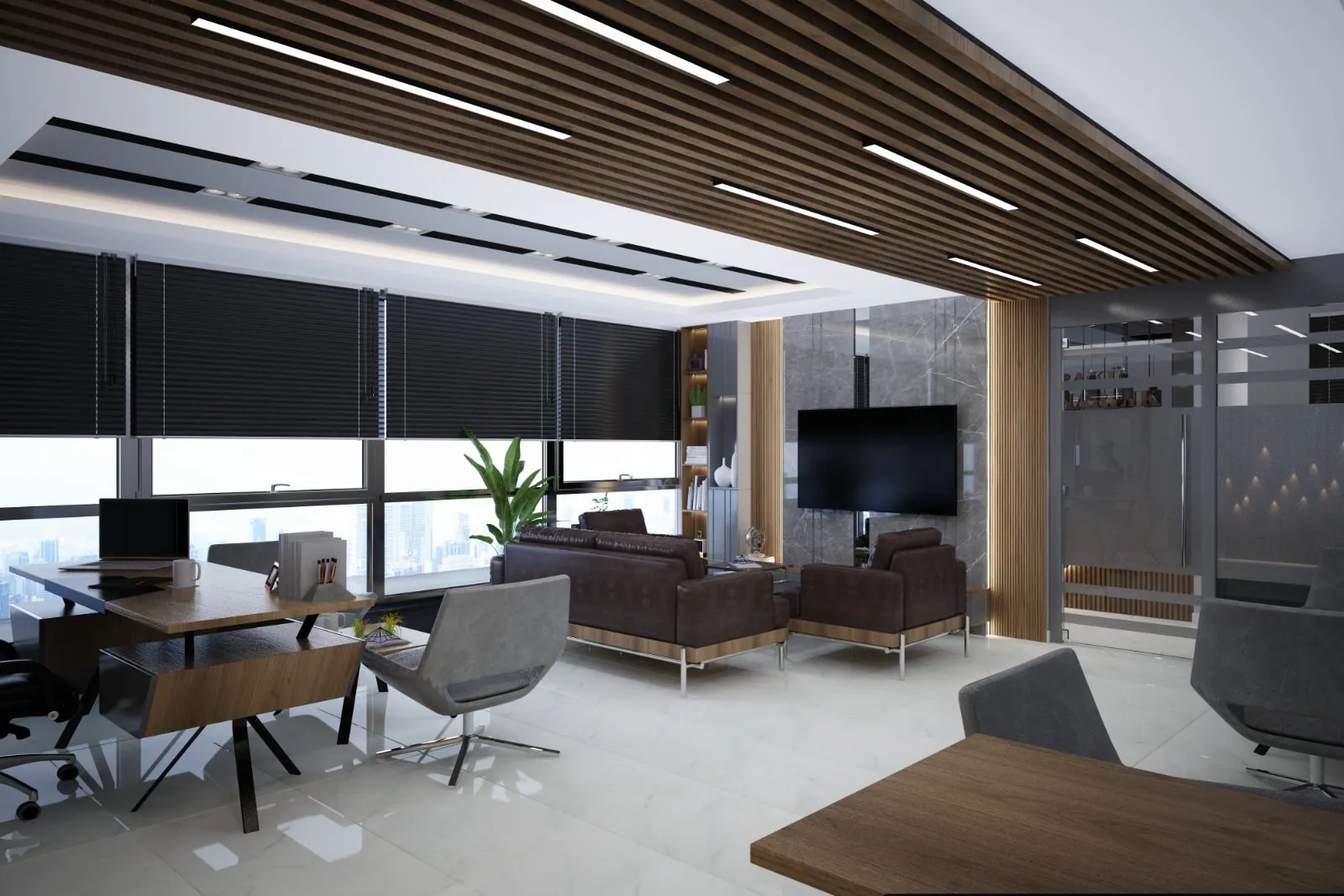
Selecting office furniture represents much more than a simple purchasing decision. Well-chosen furniture enhances employee productivity, reflects your company culture, and creates a professional impression for visitors. In this blog post, we detail the key points to consider and steps to follow when selecting office furniture for your workspace.
Contents
- Conduct a Needs Assessment
- Budget Planning
- Prioritize Ergonomics and Comfort
- Space Optimization
- Alignment with Company Identity
- Quality and Durability Factors
- Flexibility and Modularity
- Sustainability Criteria
- Technology Integration
- Seeking Professional Assistance
- Conclusion
1. Conduct a Needs Assessment {#needs-assessment}
Before beginning your office furniture selection process, it's crucial to determine your company's actual needs. Key questions to ask at this stage include:
-
What is your employee count and departmental distribution? Each department may have unique furniture requirements. Design teams might need spacious work surfaces, while management teams may require additional storage space.
-
What activities will take place in the office? Will there only be computer work, or will meetings, brainstorming sessions, and client visits also occur?
-
What is your working style? Are you implementing an open office layout, cubicle workstations, or a hybrid approach?
-
What are your future growth plans? If you anticipate staff increases in the next 3-5 years, your furniture selection should accommodate this growth.
To accurately identify your needs, you can conduct interviews with department managers and collect feedback from employees. This approach ensures not only a functional office environment but also increases employee satisfaction.
2. Budget Planning {#budget-planning}
Office furniture represents a significant investment, and a well-planned budget helps maximize the return on this investment. Consider these points when planning your budget:
-
Prioritize: Not all furniture pieces are equally important. Allocate more budget to essential items like chairs and desks where employees spend most of their time, while economizing on decorative elements.
-
Calculate total ownership cost: Consider not just the purchase price, but also shipping, assembly, maintenance, and potential replacement costs.
-
Balance quality and price: The most expensive option isn't always the best, but very cheap furniture can wear out quickly. Quality furniture often proves more economical in the medium to long term.
-
Research financing options: Leasing or installment options for large furniture purchases can help manage your cash flow.
When creating your budget, a reasonable approach is to allocate approximately 70% of the total cost to core furniture (desks, chairs, storage units), 20% to common areas, and 10% to accessories and decorative elements.
3. Prioritize Ergonomics and Comfort {#ergonomics-comfort}
The ergonomic design of your office furniture is critical for employee health and productivity. A significant portion of workforce losses and health issues stem from improper working positions.
Chair Selection:
- Adjustable back support and seat height
- Adjustable armrests
- Lumbar support feature
- Breathable, non-sweat-absorbing fabric
- Sturdy five-wheel base
Desk Selection:
- Proper height (standard 73-76 cm, but adjustable desks are ideal)
- Adequate workspace (minimum 120x80 cm)
- Correct distance for computer monitor (approximately arm's length)
- Cable management systems
- Height-adjustable desks (offering sit-stand options)
Lighting:
- Maximum utilization of natural light
- Adjustable desk lamps that reduce eye strain
- Positioning that prevents glare and reflections
While ergonomic furniture may initially appear more costly, it pays for itself in the long run by reducing workforce losses and health expenditures related to musculoskeletal disorders.
4. Space Optimization {#space-optimization}
Efficient use of your office space is important both functionally and financially. Consider these factors when planning your space:
-
Create a scaled office layout plan: Before selecting furniture, you should have a layout plan prepared with precise measurements. You can test different furniture arrangements on this plan.
-
Maintain circulation areas: Leave at least 90-120 cm between desks to allow employees to move comfortably.
-
Choose multipurpose furniture: Multifunctional pieces such as seating with storage features or work desks that convert to meeting tables save space.
-
Utilize vertical space: Wall shelves, tall cabinets, and hanging storage systems help conserve floor space.
-
Create flexible workstations: Prefer modular workstations that can be arranged according to need, rather than fixed desks.
Workspace should be planned at approximately 9-14 square meters per person. This area may vary depending on your company's business model and work arrangement. For example, companies with flexible working arrangements might need only 8 square meters per person, while sectors requiring more space, such as creative agencies, might need up to 15 square meters.
5. Alignment with Company Identity {#company-identity}
Your office furniture should reflect your company's corporate identity and culture. This alignment helps communicate your company values to both employees and visitors.
-
Use your corporate colors: You can draw inspiration from the colors in your company logo or use these colors as accents in your furniture choices.
-
Determine a style appropriate for your sector: While a more traditional and professional look might be suitable for the financial services sector, more colorful and modern designs might be preferred for creative agencies.
-
Reflect your mission: If you value sustainability, you might prefer furniture made from recycled materials.
-
Support your work culture: If you encourage a collaborative work environment, it would make sense to create open seating arrangements and common workspaces.
For example, modern, minimalist, and functional furniture would be suitable for a technology company, while more classical, quality wooden furniture might be more appropriate for a law firm. The important thing is that your furniture choice is consistent with the impression you want to give your customers.
6. Quality and Durability Factors {#quality-durability}
Office furniture is an important investment, and thinking long-term will ultimately lead to a more economical choice. Pay attention to these criteria when evaluating quality and durability:
-
Material quality: Solid wood or quality veneer in wooden furniture, thick steel frames in metal furniture are indicators of durability.
-
Manufacturing techniques: Welded joints in frames rather than screwed joints, mortise and tenon joints in wooden furniture are more durable.
-
Warranties: Long warranty periods show the manufacturer's confidence in their product. Look for a minimum 5-year warranty, especially for heavily used furniture.
-
Availability of spare parts: Especially for furniture with mechanisms, it's important that parts such as wheels and armrests can be replaced.
-
Test certificates: Compliance certificates with standards such as EN, ISO, TSE show that the furniture meets certain quality standards.
Although quality furniture may initially be more expensive, it is more economical in the long run due to its longer lifespan and lower maintenance requirements. The average lifespan of an office chair should be 7-10 years, and a work desk 10-15 years.
7. Flexibility and Modularity {#flexibility-modularity}
Change is inevitable in the modern business world. Teams grow, shrink, restructure, and working methods change. Therefore, your chosen office furniture should be flexible enough to adapt to these changes.
-
Modular workstations: Desk systems that can be combined in different arrangements allow you to easily change your office layout.
-
Adjustable components: Height-adjustable desks adapt to different working positions and create an ergonomic working environment for employees of different heights.
-
Furniture with wheels: Easily movable furniture allows for quick rearrangement.
-
Multipurpose pieces: Work areas that can transform into meeting areas or dividers that can also be used as storage units help you use your space more efficiently.
-
Divider systems: Using movable dividers instead of fixed walls offers flexibility to rearrange your space according to need.
Modular and flexible furniture solutions reduce the need to purchase new furniture during your company's growth and change processes. This both provides economic savings and contributes to your sustainability goals.
8. Sustainability Criteria {#sustainability}
Today, sustainability is not just a preference but a part of social responsibility. It's important to consider environmental impacts when choosing your office furniture:
-
Certified materials: Prefer materials obtained from sustainable sources, such as FSC (Forest Stewardship Council) certified wood.
-
Low VOC emissions: Volatile organic compounds (VOCs) reduce indoor air quality. Choose furniture with low emission certifications such as GREENGUARD.
-
Recyclable materials: Furniture made from materials that can be recycled at the end of their useful life is an environmentally friendly choice.
-
Local manufacturers: Furniture sourced from local manufacturers reduces the carbon footprint from transportation.
-
Long-lasting designs: Durable and timeless designed furniture eliminates the need for frequent replacement, thereby reducing waste.
Sustainable furniture selection contributes to your company's corporate social responsibility goals while creating a healthier working environment for your employees.
9. Technology Integration {#technology-integration}
Modern offices are technology-centered, and your furniture should reflect this reality. Technology-friendly furniture choices increase efficiency and reduce cable clutter:
-
Integrated power and USB ports: Power outlets and USB charging ports placed on the desk surface or edges allow devices to be charged in an easily accessible manner.
-
Cable management systems: Cable channels and baskets mounted under desks create an organized and safe workspace.
-
Wireless charging surfaces: Wireless charging points integrated into the desk surface offer a modern working environment.
-
Media integration: Integrated systems for screen sharing in meeting tables or features prepared for projection.
-
Acoustic solutions: Sound-insulated phone booths or meeting areas optimized for video conferences.
Furniture rich in technology integration may present a higher initial cost, but it's a good investment due to its contributions to employee productivity and savings from later modification costs.
10. Seeking Professional Assistance {#professional-assistance}
Office furniture selection is a complex process, and seeking professional assistance can make this process more efficient:
-
Interior architects and office design specialists: They can provide expert opinions on space planning, ergonomics, and aesthetics.
-
Furniture suppliers: Experienced suppliers can share experiences gained from their other clients in similar sectors and suggest solutions suitable for your needs.
-
Ergonomics consultants: If you prioritize your employees' health, you can seek support from ergonomics experts.
-
Testing opportunity: Many furniture suppliers offer samples that you can test before purchasing. It's important to test essential pieces such as chairs and desks before buying.
Professional support may seem like an additional cost initially, but it helps you save in the long run by ensuring you make the right choices. It's also critical for completing your projects on time and within budget.
11. Conclusion {#conclusion}
Office furniture selection is a strategic decision that shapes your company's working environment. A well-planned and implemented office furniture strategy increases employee productivity, strengthens your corporate identity, and optimizes your costs.
By following the steps we've outlined in this blog post, you can make your office furniture selection consciously and systematically:
- First, accurately analyze your needs
- Plan a realistic budget
- Prioritize ergonomics and comfort
- Consider space optimization
- Make choices consistent with your company identity
- Don't compromise on quality and durability
- Consider flexibility and modularity
- Evaluate sustainability criteria
- Don't forget technology integration
- Seek professional support when necessary
At Baku Architecture, we are pleased to offer solutions that meet your needs, are ergonomic, aesthetic, and durable for your office furniture selection. With our 12 years of experience and expert staff, we are ready to be by your side at every stage of your office project.
You can contact us for professional support in office furniture selection or to learn about custom design solutions. Our expert team is always ready to understand your needs and offer you the most suitable solutions.
This blog post was prepared by Baku Architecture Construction Contracting and Furniture Decoration Manufacturing. Visit our website for more information about our office furniture and interior architecture solutions.




